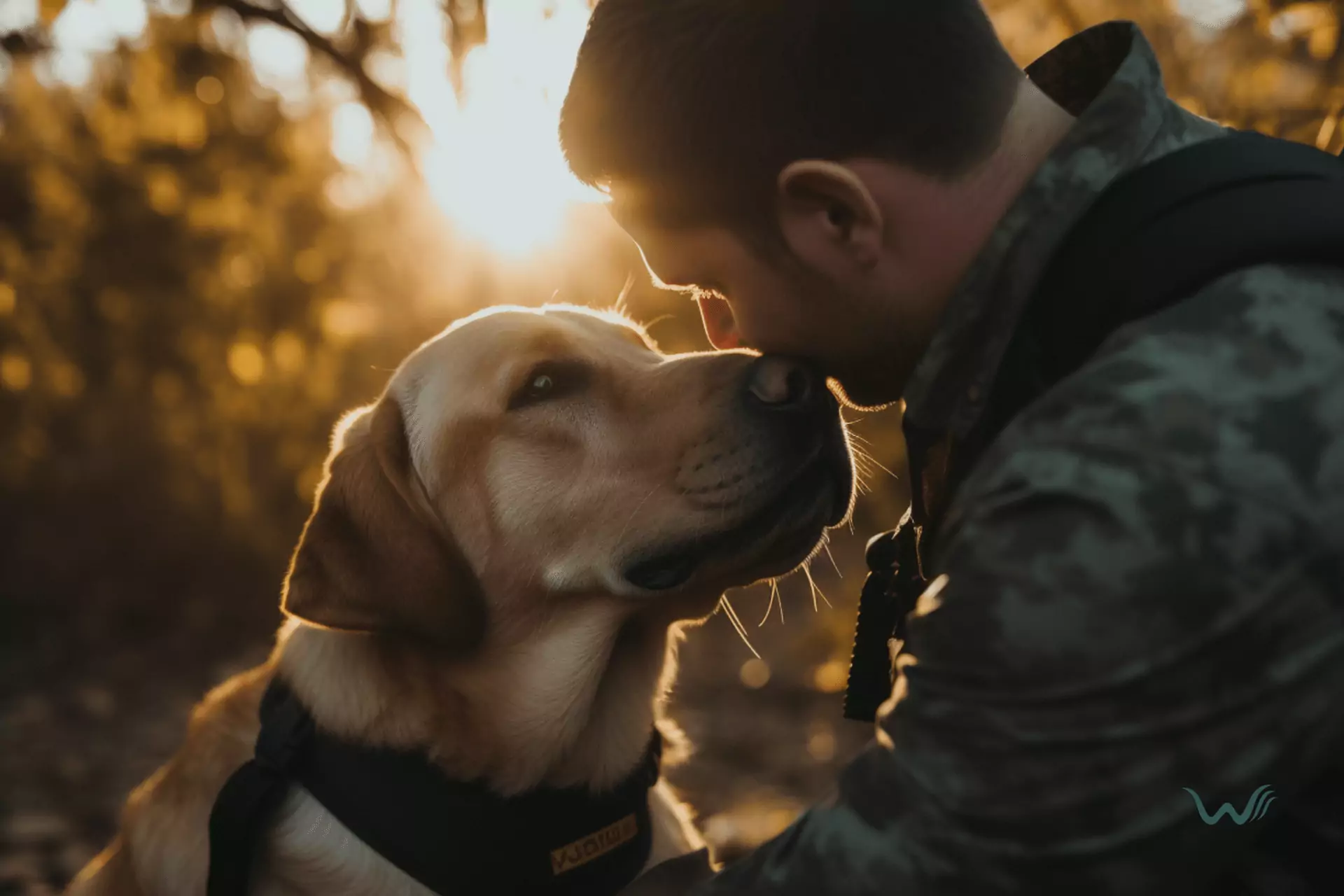

Strengthening Trust & Joy: Positive Training for ESAs
by Haley Mills
Last updated: April 21, 2024
Verified and Approved by:
Angela Morris,
MSW, LCSW
Fact Checked

Are you tired of having a pet that sits there, staring blankly into space while you pour your heart out? Do you yearn for a furry companion that not only listens to your problems but also provides the emotional support you desperately need?
Well, look no further, because emotional support dogs are here to save the day! These incredible creatures have the power to uplift your spirits and make you feel loved, and with the help of positive reinforcement training, you can strengthen your bond with them even further.
Now, you might be thinking, “Why on earth would I need to train an emotional support dog? Shouldn’t they just inherently know how to comfort and support me?” Ah, my friend, that’s where the magic of positive reinforcement training comes into play.
You see, while emotional support dogs have an innate ability to sense your emotions and provide comfort, training them helps in channeling their energies towards becoming the best support system you could ever ask for. By using positive reinforcement techniques, you can teach your furry friend how to respond to your emotional cues, understand your needs, and provide the support you crave.
Key Takeaways
- Emotional support dogs provide comfort and support to their owners.
- Positive reinforcement training strengthens the bond between owner and emotional support dog.
- Emotional support dogs can sense emotions and provide comfort.
- Positive reinforcement training increases learning speed and overall happiness in dogs.
Understanding Emotional Support Dogs and their Role
Emotional support dogs, or as I like to call them, “furry therapists,” are not just your average pets. They have a special gift for understanding human emotions and offering unconditional love and support. It’s like having a best friend who also happens to have a wagging tail and four paws.
These dogs are superheroes in fur coats, ready to swoop in and save the day with their endless cuddles and wet nose kisses. They have an uncanny ability to sense when you’re feeling down and will snuggle up next to you, reminding you that you’re not alone. And let’s not forget their incredible listening skills. You can pour out your heart to them, and they’ll sit there, ears perked up, nodding along in complete understanding (even if they have no idea what you’re saying).
But their role goes beyond providing emotional support. These furry companions are also experts in breaking the ice and making new friends. Take them for a walk, and you’ll be amazed at how many people stop to pet them and strike up a conversation. They have a way of bringing people together, creating connections, and spreading joy wherever they go.
The Benefits of Positive Reinforcement Training
Interestingly, studies have shown that using rewards-based methods significantly increases your furry friend’s learning speed and overall happiness. That’s right, by dishing out treats and showering them with praise, you can turn your emotional support dog into a canine Einstein who can’t stop wagging their tail.
It’s like a win-win situation – you get a well-behaved and happy pup, and your pup gets all the treats and belly rubs they could ever dream of. Who knew training could be so rewarding?
But wait, there’s more! Positive reinforcement training doesn’t just make your dog a smarty-pants, it also strengthens the bond between the two of you. It’s like a trust-building exercise where you become the ultimate treat dispenser and your dog becomes your biggest fan.
Every time you reward them for good behavior, you’re telling them, “Hey, I see you and I appreciate you.” And trust me, your dog will eat that up like it’s their favorite chew toy.
Establishing Trust and Building a Strong Bond
To build a strong bond with your emotional support dog, it’s crucial to establish trust and create a deep connection. Think of it as building the foundation of a solid relationship.
You want your furry friend to trust you like they trust their favorite treat falling from the sky (which, let’s be honest, is pretty darn trust-worthy). So, how do you go about establishing this trust? Well, it starts with positive reinforcement training. Shower your pup with praise, treats, and belly rubs whenever they exhibit good behavior. Show them that you’re their biggest fan, their number one cheerleader. And hey, who doesn’t want a cheerleader on their side? Trust me, you want to be that cheerleader for your emotional support dog.
Now, creating a deep connection with your fluffball is all about spending quality time together. Think of it as a date night, but without the fancy restaurant and candlelight (unless you’re into that, in which case, go for it!). Take your doggo on walks, play fetch at the park, and engage in activities that you both enjoy. Show them that you’re not just their human, but their partner in crime and their best friend.
Training Techniques for Emotional Support Dogs
Get ready to dive into the world of training techniques for your furry companion, where you’ll unlock the secrets to building an unbreakable connection. Training your emotional support dog is not only a way to teach them important skills, but also an opportunity to strengthen your bond and create a harmonious relationship. By using positive reinforcement techniques, you can make the training process enjoyable and rewarding for both you and your furry friend.
One effective training technique is clicker training. This involves using a small handheld device that makes a clicking sound when pressed. The clicker serves as a marker to let your dog know that they have performed the desired behavior correctly. To get started with clicker training, follow these simple steps:
- Introduce the clicker: Begin by associating the clicker’s sound with a reward. Press the clicker and immediately give your dog a treat. Repeat this several times until your dog understands that the clicker means a reward is coming.
- Pair the clicker with a command: Once your dog is familiar with the clicker, you can start using it to reinforce specific commands. For example, if you want your dog to sit, say the command “sit” and wait for them to perform the behavior. As soon as they sit, press the clicker and give them a treat.
How Can Positive Reinforcement Training Benefit an Emotional Support Animal?
Positive reinforcement training can greatly enhance the benefits of emotional support animals. By using rewards and praise, the animal is motivated to exhibit desired behaviors, which can ultimately improve the owner’s emotional well-being. This type of training can strengthen the bond between the animal and its owner, leading to better support.
Maintaining and Strengthening the Bond over Time
To maintain and deepen your connection with your emotional support dog, it’s important to consistently engage in activities that promote trust and understanding between the two of you. Remember, your furry friend is not just a walking, barking, tail-wagging stress reliever; they’re also a living being with emotions and needs.
So, here are a couple of ideas to keep that bond strong and your emotional support dog feeling loved and appreciated:
- Playtime: Who says playtime is just for kids? Dogs love to play too! Engage in interactive games like fetch or hide-and-seek to stimulate your emotional support dog’s mind and keep them physically active. Not only will this strengthen your bond, but it’ll also provide much-needed exercise for both of you. Plus, who can resist a game of tug-of-war with a wagging tail and slobbery toy?
- Quality time: Just like humans, dogs crave quality time with their loved ones. Set aside dedicated time each day to engage in activities that both you and your emotional support dog enjoy. Whether it’s going for a leisurely walk in the park, cuddling up on the couch for a movie night, or simply sitting outside and enjoying the fresh air, these moments of togetherness will strengthen your bond and deepen your connection. And let’s be honest, who doesn’t want a little extra snuggle time with their furry therapist?
Remember, building a strong bond with your emotional support dog is an ongoing process. By consistently engaging in activities that promote trust and understanding, you’ll not only strengthen your connection but also create a happier and healthier relationship.
Frequently Asked Questions
Can any dog be trained to be an emotional support dog?
Of course, any pupper has the potential to be your emotional sidekick! With the right training and some puppy love, your furry friend can become the ultimate support system you’ve always dreamed of.
Is positive reinforcement training effective for all types of emotional support dogs?
Yes, positive reinforcement training is effective for all types of emotional support dogs. It’s like giving them a treat for being awesome! Plus, it strengthens the bond between you and your furry friend. Win-win!
How long does it typically take to establish trust and build a strong bond with an emotional support dog?
Building trust and forming a strong bond with your emotional support dog varies depending on factors like their background and personality. It can take anywhere from a few weeks to several months of consistent positive reinforcement training and bonding activities.
Are there any specific training techniques that should be avoided when training emotional support dogs?
When training emotional support dogs, it’s important to avoid harsh or punitive techniques. Stick to positive reinforcement methods, like rewards and praise, to build a strong bond based on trust and love. No woof about it!
What are some activities or exercises that can help maintain and strengthen the bond with an emotional support dog over time?
To maintain and strengthen your bond with your emotional support dog, try activities like hiking, playing fetch, or even having a movie night together. Remember, laughter is the best medicine, so don’t be afraid to be silly and have fun!
Certify Your Emotional Support Animal Today

Why You Can Rely on Us?
At Wellness Wag, we believe your pet deserves care rooted in both science and compassion. Each article is carefully researched, written in clear language for pet owners, and then reviewed by qualified professionals to ensure the information is evidence-based, current, and practical for real-life care. Our goal is to help you feel confident in making informed decisions about your pet’s health and well-being.
Reviewed by
Angela Morris, MSW, LCSW
Angela is a licensed clinical social worker with 20 years of experience in patient advocacy and community mental health. She has assisted numerous clients with ESA evaluations and brings a deep understanding of disability accommodations, ensuring that all information is accurate, supportive, and practical.

Written by :
Haley Mills
Last Updated :
April 21, 2024












